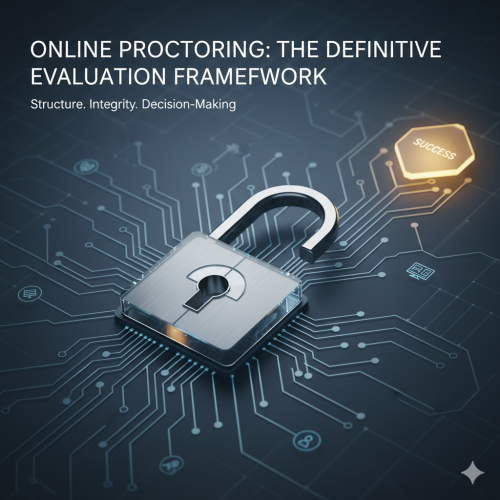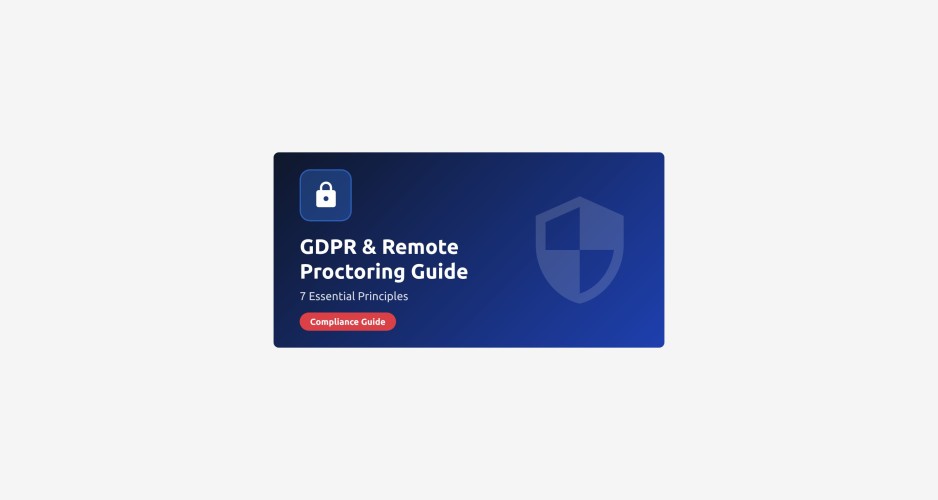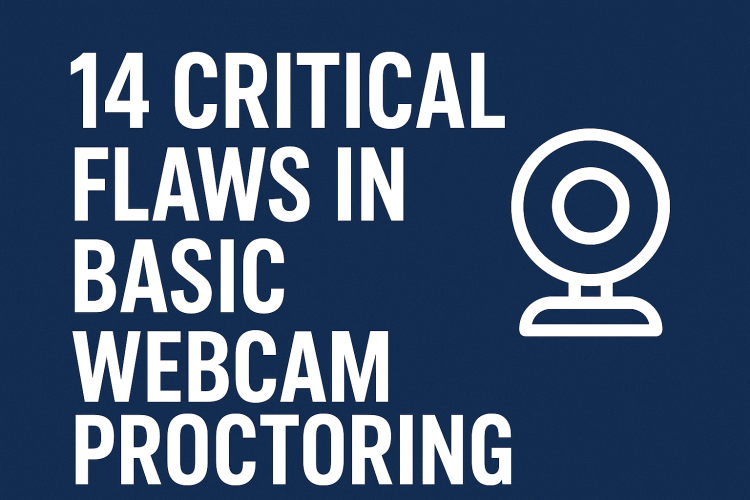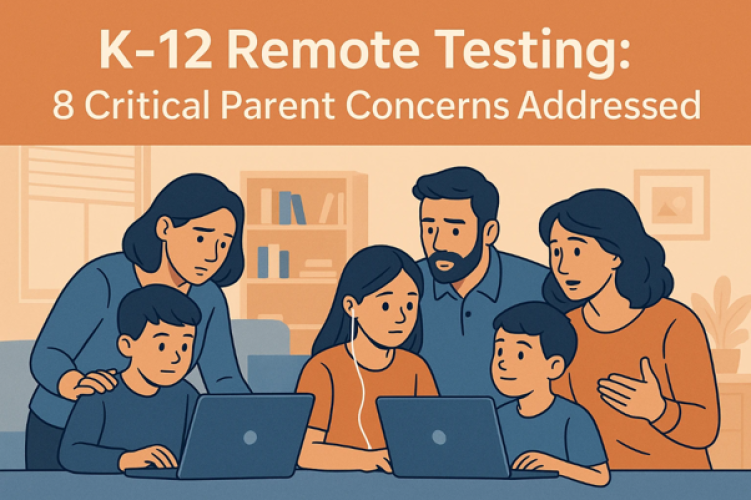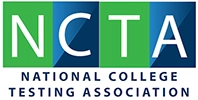Choosing an online proctoring solution is one of the most impactful technology decisions an educational institution can make. It affects academic integrity, student experience, faculty workload, operational costs, and your institution's ability to scale online programs.
Yet many institutions approach this decision without a structured evaluation framework, leading to costly mistakes: solutions that don't scale, student backlash, faculty resistance, or security failures.
This comprehensive guide provides a step-by-step framework for evaluating proctoring solutions — helping you ask the right questions, avoid common pitfalls, and select a solution that will serve your institution for years to come.
Part 1: Before You Evaluate Any Vendor
Define Your Requirements First
The #1 mistake institutions make: Letting vendors define their requirements.
The result: You end up evaluating vendors based on their strengths, not your actual needs.
Requirements Assessment Framework
Answer these questions before contacting any vendors:
A. Institutional Context
- How many students take exams per semester? (Average and peak numbers)
- What types of programs do you offer? (Undergraduate, graduate, certificate, professional)
- Are you primarily online, hybrid, or in-person with growing online components?
- What is your growth projection over the next 3-5 years?
B. Exam Characteristics
- What exam formats do you use? (MCQ, essay, oral, practical, coding)
- What is the typical exam duration? (1 hour, 3 hours, 24-hour take-home)
- What are the stakes levels? (High-stakes finals, mid-stakes quizzes, low-stakes practice)
- How frequently do you administer exams? (Daily, weekly, semester-based)
C. Student Population
- Where are your students located? (Single city, national, international)
- What devices do they typically use? (Laptops, desktops, tablets, phones)
- What is their internet connectivity like? (Urban broadband, rural 3G/4G, variable)
- What accessibility accommodations are commonly needed?
D. Institutional Constraints
- What is your budget range? (Per student, per exam, or total annual)
- What is your implementation timeline? (Immediate, within 6 months, next academic year)
- What technical infrastructure exists? (LMS platform, IT support capacity)
- What are your compliance requirements? (Regulatory, accreditation, privacy)
Part 2: Understanding Proctoring Models
Not all online proctoring works the same way. Understanding different models helps you match solutions to your needs.
Model 1: Automated (AI-Only) Proctoring
How It Works:
- AI monitors webcam, screen, audio, and behavioral patterns
- System flags suspicious activities automatically
- Faculty or administrators review flagged incidents
- No human proctors during exam
Best For:
- High-volume, frequent assessments
- Cost-sensitive implementations
- Lower-to-medium stakes exams
- Tech-comfortable student populations
Considerations:
- Requires reliable internet and webcam
- Potential for false positives
- May not catch all sophisticated cheating
- Student concerns about AI fairness
Model 2: Live (Human) Proctoring
How It Works:
- Human proctors monitor students in real-time via webcam
- One proctor watches multiple students simultaneously
- Proctors can intervene immediately
- Recorded sessions for post-exam review
Best For:
- High-stakes examinations
- Lower volume assessments
- Compliance-heavy scenarios
- Institutions prioritizing human judgment
Considerations:
- Higher cost per exam
- Scheduling complexity
- Proctor availability constraints
- Limited scalability
Model 3: Hybrid (AI + Human Review)
How It Works:
- AI monitors all students and flags suspicious behavior
- Human reviewers examine flagged incidents after exam
- Combines automation scale with human judgment
- Reduces false positive impact on students
Best For:
- Balanced approach to cost and quality
- Medium-to-high stakes exams
- Large student populations
- Institutions wanting both efficiency and accuracy
Considerations:
- Review process takes time
- Quality depends on reviewer training
- More expensive than AI-only
- Still requires good technology access for students
Model 4: Record and Review
How It Works:
- Exam session fully recorded
- No real-time monitoring
- Review only if cheating suspected
- Deterrent effect from knowing recording exists
Best For:
- Budget-constrained implementations
- Lower-stakes assessments
- Transition from honor system
- Deterrence-focused approach
Considerations:
- Does not prevent cheating in real-time
- Review is time-intensive if needed
- Requires significant storage
- Less effective for sophisticated cheaters
Part 3: Evaluation Criteria Framework
Use these ten criteria to assess any proctoring solution:
1. Security Capabilities
What to Evaluate:
- Identity verification methods (facial recognition, ID check, biometrics)
- Monitoring scope (webcam, screen, audio, browser lockdown)
- Fraud detection techniques (AI analysis, behavioral patterns)
- Prevention mechanisms (copy-paste blocking, tab switching detection)
Questions to Ask:
- What types of cheating can your system detect?
- How do you minimize false positives?
- Can you demonstrate the system catching actual cheating attempts?
- What evidence is provided for violations?
2. Student Experience
What to Evaluate:
- Device and browser compatibility
- Bandwidth requirements
- Setup complexity
- Accessibility features
- Support availability during exams
Questions to Ask:
- What devices and operating systems are supported?
- What minimum bandwidth is required?
- How do you accommodate students with disabilities?
- What happens if a student experiences technical issues during an exam?
3. Faculty and Administrator Experience
What to Evaluate:
- Exam setup process
- Violation review workflow
- Analytics and reporting
- Time required for administration
- Training requirements
Questions to Ask:
- How long does it take faculty to set up an exam?
- How much time is needed to review a typical exam?
- What training is required?
- What insights are provided beyond security monitoring?
4. Technical Integration
What to Evaluate:
- LMS compatibility
- Single sign-on support
- API availability
- Implementation complexity
- Ongoing IT requirements
Questions to Ask:
- Which LMS platforms do you integrate with?
- How long is typical implementation?
- What IT resources are needed?
- Can we customize the integration?
5. Scalability and Reliability
What to Evaluate:
- Maximum concurrent users
- System uptime history
- Performance under load
- Geographic distribution
- Disaster recovery
Questions to Ask:
- What is your maximum tested concurrent user load?
- What is your uptime track record?
- How do you handle system failures during exams?
- Can you handle our peak exam periods?
6. Cost Structure
What to Evaluate:
- Pricing model (per exam, per student, flat fee)
- What's included in base price
- Additional costs (setup, training, support, bandwidth)
- Contract terms and flexibility
- Volume discounts
Questions to Ask:
- What is your complete pricing structure?
- Are there any hidden fees?
- How does pricing change as we scale?
- What contract terms do you offer?
7. Data Privacy and Compliance
What to Evaluate:
- Data storage locations
- Security certifications
- Compliance with regulations
- Data retention policies
- Privacy practices
Questions to Ask:
- Where is data stored?
- What security certifications do you have?
- How do you comply with relevant regulations?
- What are your data retention and deletion policies?
8. Support and Training
What to Evaluate:
- Support availability (24/7 vs. business hours)
- Response time commitments
- Training programs offered
- Implementation assistance
- Ongoing support model
Questions to Ask:
- What support is available during exam periods?
- What are your response time commitments?
- What training do you provide?
- Who is our point of contact?
9. Vendor Track Record
What to Evaluate:
- Company history and stability
- Customer base size and type
- References from similar institutions
- Product roadmap
- Financial stability
Questions to Ask:
- How long have you been in business?
- How many institutions use your solution?
- Can you provide references?
- What is on your product roadmap?
10. Flexibility and Customization
What to Evaluate:
- Customization options
- Policy configuration
- Reporting flexibility
- Integration extensibility
- Feature request process
Questions to Ask:
- Can we customize the system to our specific needs?
- How flexible are security policies?
- Can we modify the user interface?
- How do you handle feature requests?
Part 4: The Evaluation Process
Phase 1: Research and Shortlisting (2-3 weeks)
Tasks:
- Research available solutions online
- Read reviews and case studies
- Attend demos or webinars
- Create shortlist of 3-5 vendors
- Request initial information and pricing
Deliverable: Shortlist of vendors for deeper evaluation
Phase 2: Detailed Evaluation (3-4 weeks)
Tasks:
- Schedule comprehensive demos from each vendor
- Request detailed proposals and contracts
- Check references (speak to current customers)
- Evaluate against your criteria framework
- Involve stakeholders (faculty, IT, students, finance)
Deliverable: Scoring matrix comparing vendors
Phase 3: Pilot Testing (1 semester)
Tasks:
- Select top choice for pilot
- Implement with limited student cohort (100-500 students)
- Test with 2-3 different course types
- Gather feedback from students and faculty
- Measure against success metrics
Deliverable: Pilot evaluation report with go/no-go recommendation
Phase 4: Contract Negotiation (2-3 weeks)
Tasks:
- Negotiate pricing and terms
- Review contract with legal team
- Ensure SLAs meet requirements
- Clarify implementation timeline
- Define success criteria
Deliverable: Signed contract or decision to reconsider
Phase 5: Full Implementation (Varies)
Tasks:
- Plan phased rollout
- Conduct comprehensive training
- Communicate with all stakeholders
- Monitor closely during first exams
- Gather feedback and optimize
Deliverable: Fully operational proctoring system
Part 5: Common Evaluation Mistakes to Avoid
Mistake 1: Focusing Only on Features
Instead: Evaluate based on your actual use cases and requirements
Mistake 2: Ignoring Student Perspective
Instead: Include student representatives in evaluation and pilot
Mistake 3: Choosing Based on Price Alone
Instead: Calculate total cost of ownership including support, training, and ongoing costs
Mistake 4: Skipping the Pilot
Instead: Always test with real exams before full commitment
Mistake 5: Not Checking References
Instead: Speak to at least 2-3 current customers, preferably similar to your institution
Mistake 6: Ignoring Vendor Stability
Instead: Assess vendor's financial health and long-term viability
Mistake 7: Overlooking Integration Complexity
Instead: Involve IT team early and assess technical requirements realistically
Mistake 8: Failing to Plan for Change Management
Instead: Develop communication and training plan for all stakeholders
Part 6: Questions to Ask at DIDAC India 2025
When visiting proctoring vendors at DIDAC India 2025, use these questions:
Technical Questions:
- Can you show me a live demo where someone attempts to cheat?
- What happens when students have poor internet connectivity?
- How do you handle mid-exam technical failures?
Implementation Questions:
- What is the typical implementation timeline?
- What training and support do you provide?
- What are the common implementation challenges?
Cost Questions:
- What is your complete pricing model?
- What additional costs should we anticipate?
- What booth-exclusive offers are available?
Track Record Questions:
- Which institutions in India currently use your solution?
- Can you connect me with a similar institution for reference?
- What has been your biggest implementation challenge and how was it resolved?
Visit Proctoring Solutions at DIDAC India 2025
The best way to evaluate proctoring solutions is to see multiple vendors in person.
DIDAC India 2025:
- Dates: November 18-20, 2025
- Venue: Yashobhoomi Convention Centre, New Delhi
Proctor360 will be at Booth F31 demonstrating our AI-powered proctoring platform.
What We Offer at Our Booth:
📋 Evaluation Framework: Get this guide in checklist format
🎯 Live Demonstrations: Experience the system hands-on
💬 Honest Consultations: We'll help you evaluate ALL options, not just ours
📊 Comparison Tools: Framework for comparing multiple vendors
🎁 Booth Benefits: Exclusive offers for DIDAC visitors
We encourage you to visit multiple vendors and compare carefully.
Conclusion: Make an Informed Decision
Selecting an online proctoring solution requires careful evaluation across multiple dimensions:
✅ Security and integrity capabilities
✅ Student and faculty experience
✅ Technical integration and scalability
✅ Total cost of ownership
✅ Compliance and data privacy
✅ Vendor stability and support
Key Success Factors:
- Define requirements before evaluating vendors
- Involve all stakeholders in the decision
- Always conduct a pilot before full commitment
- Check references from similar institutions
- Think long-term, not just immediate needs
The right proctoring solution will serve your institution for years, enabling quality online education while maintaining academic integrity.
Visit DIDAC India 2025 to compare your options in person. We'll see you at Booth F31! 🚀
About Proctor360
Proctor360 provides AI-powered remote proctoring solutions for educational institutions. We're committed to helping you make the best decision for your institution — whether that's choosing our solution or finding the right alternative.
Learn more:
